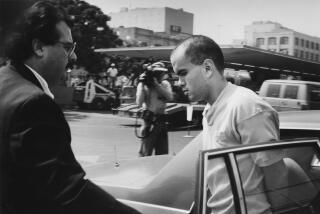Murder in Milwaukee: Experts Struggle to Explain Dahmer’s Compulsion : Crime: His behavior was always on the edge, childhood acquaintances say. But no one intervened to help him, and his problems escalated.
BATH TOWNSHIP, Ohio — There is no easy explanation for Jeffrey Dahmer.
In semi-rural Bath Township--where he witnessed his parents at war; where he collected animals’ bones and carcasses; where he first took to drink; where in a single year he attended his senior prom and, he says, killed his first man--there are abundant clues to a burgeoning evil.
But there are no simple answers to the mysteries of a monstrous heart. There are no signposts that say that this young man, though abused and afflicted, could grow up to kill 17 other young men.
“He’s done monstrous acts, yet he’s a human being. Why? Only Jeffrey can answer that,” said Susan Lehr, a former neighbor.
Jeffrey Dahmer’s father, Lionel, says that his son was sexually abused by a neighborhood boy when he was 8 years old, about the time the family moved here.
It is not clear what effect the episode had on the youngster. But it is certain that other unhappy events of childhood lingered, chief among them the bitter breakup of his parents’ marriage.
Their divorce was granted on July 24, 1978, after each charged the other with “extreme cruelty and gross neglect of duty.”
Acrimony continued; two years later, Joyce Dahmer called Bath Township police with a report of a shouting and shoving match with her ex-husband. There were no arrests.
“The police were out several times,” Lehr said.
Her four sons were playmates of Dahmer’s. “At the time I knew him, there was something devastating going on in his life and there wasn’t anybody there to help him. I feel bad about that,” she said.
During the divorce, Jeffrey Dahmer was left alone. His mother moved to Wisconsin with his younger brother, David; his father had moved out of the house. He was left with no food, no money and a broken refrigerator.
It was at that time, on June 18, 1978, Dahmer told police, that he killed his first victim: a hitchhiker brought back to the house for a couple of beers. Dahmer said he choked the man with a barbell, smashed the body to bits with a sledgehammer and scattered the pieces in his yard. A recent search turned up more than 500 pieces of bone.
“The guy wanted to leave and I didn’t want him to leave,” the 31-year-old Jeffrey Dahmer told police 13 years later.
The people who knew Dahmer in those days may not have known the depths of his loneliness, but they were well aware of his solitude, and of his penchant for bizarre behavior and odd pastimes.
Young Dahmer kept the bones of chipmunks, squirrels, dogs, cats, groundhogs and raccoons inside formaldehyde-filled pickle jars that lined his childhood clubhouse. He roamed the neighborhood for road kills that shared space in an old toolshed with spiders, praying mantises and other bugs in specimen jars.
Nearby was a cemetery that struck Dahmer’s chums as even more bizarre.
“He had a little graveyard with animals buried in it. There were skulls placed on top of little crosses. He had quite a collection of skeletons,” said Eric Tyson, 28, a former neighbor.
Schoolmate Mike Costlow told The Plain Dealer in Cleveland that Dahmer also collected stuffed rabbits, owls and small birds. When Costlow asked about taxidermy in 1978, Dahmer told him: “I always wanted to do that to a human.”
In seventh grade, classmate Chip Crofoot noticed Dahmer sipping gin from his locker and coming to school drunk. “I don’t remember much about him other than his drinking. He pretty much kept to himself all the time,” Crofoot said.
Dahmer played clarinet and intramural tennis in school. He had a chemistry set and showed an early interest in biology. He made average grades because of a combination of A’s and Ds.
Acquaintances recall Dahmer drawing chalk outlines of fictional bodies, faking epileptic fits at the mall, yelling out at inappropriate times and sneaking into the picture of the National Honor Society when he didn’t belong. His face is blotted out of the group photo in the Revere High School yearbook.
Senior-prom date Bridget Geiger remembered Dahmer as painfully shy but polite: “He didn’t say two words to me. He didn’t even kiss me good night.”
She said she attended a party at Dahmer’s house several weeks later but left because it involved a seance and someone suggested contacting the devil.
Dahmer failed to get past the first semester at Ohio State University. He sold his blood to buy alcohol. He joined the Army on Dec. 29, 1978, but was discharged in 1981, about nine months before his hitch was up. Drinking again.
Army buddies who served with him as a medic in Germany said he mixed Beefeater martinis in his barracks from a briefcase that contained shakers, stirrers and fancy flasks. When he drank, he listened to Black Sabbath and other rock music on his headphones.
“He’d be shut out from the rest of the world. He’d drink until he passed out, then wake up and start again. He didn’t even go out for chow,” said David Rodriquez of Springfield, Mass.
“He was smart, but he just wanted to slide by,” added Michael Masters of New York’s Long Island. “He was just goofy. He always had that look about him, that sinisterness. He was on a steady decline in life. He was on a losing skid and didn’t know how to pick himself up.”
After the Army discharge, Dahmer worked at a sandwich shop in Florida and slept on the beach. He returned to Ohio, then went to live with his grandmother in the Milwaukee suburb of West Allis.
Some scrapes with the law hinted at an anger seething inside: an arrest for public drunkenness Oct. 7, 1981, in Ohio; disturbing the peace by dropping his pants in front of a crowd in Wisconsin on Aug. 7, 1982; lewd and lascivious behavior in Milwaukee on Sept. 8, 1986.
A 1988 allegation that he drugged an Illinois man and tried to take his money was dropped for lack of evidence by West Allis police.
During his stay at his grandmother’s, Dahmer said he killed three times before he moved into a one-bedroom flat in a tough Milwaukee neighborhood.
Meanwhile, he was hired in 1985 as a laborer on the graveyard shift at the Ambrosia Chocolate Co. for $8.75 an hour.
In 1989, he was convicted of fondling a 13-year-old boy he had lured with the promise of $50 if the boy posed for pictures. His five-year sentence was suspended, and he served 10 months in a work-release program that allowed him to keep his night job at the chocolate factory.
Dahmer told police the killings resumed when his time in the work-release program was up.
Then, last July 14, he was fired from his job for chronic absenteeism.
On July 22, a handcuffed man escaped from his apartment and alerted police; they found the remains of 11 bodies Dahmer admitted dismembering, including four heads in a refrigerator and freezer plus seven acid-washed skulls.
In all, Dahmer admitted strangling and butchering 17 males over a 13-year period. He told police he had sex with four of the corpses, and he saved the heart of one victim “to eat later.”
This is the life trail left behind by Jeffrey Dahmer--a trail that experts hope will lead them to some understanding of why he did what he did.
David Silber, a psychologist at George Washington University, pointed to the animal remains Dahmer collected as a youth. “His behavior didn’t change. The objects changed,” Silber said.
“This is a person that is very deficient in some ways. His character probably wasn’t very strong to begin with, and it got beaten down by ways in which he was treated throughout life,” the psychologist said.
“If there’s anything monstrous about him, it’s the monstrous lack of connection to all things we think of as being human--guilt, remorse, worry, feelings that would stop him from hurting, killing, torturing,” he said.
Park Dietz, a forensic psychiatrist from Newport Beach, Calif., said that of the serial killers he studied, 58% strangled their victims.
“It’s a very personal, intimate means. One can actually feel the victim expire, see them go into convulsions and hear the last efforts to breathe,” said Dietz, a consultant to the FBI.
Dietz also said serial killers are apt to photograph their work, make a journal and keep trophies--either body parts or articles of clothing.
“In absolute contrast to the stereotype, they are the most controlled, calculated, cunning offenders,” Dietz said. “What’s so hard for people to understand is that their level of desire and need to do it is the same as the ordinary man’s desire to have ordinary sexual relations.”
An FBI report completed in the 1970s notes that serial killers almost always are white males, loners from troubled homes who are smart but underachieving. There often is physical, sexual or psychological abuse as a child. As adolescents, they show cruelty to animals about 46% of the time.
An essential feature is being sexually aroused by their bloody handiwork. The victims are merely objects--”These were sexual props, not people,” Dietz said.
And killing does give them pleasure. “They keep souvenirs to remember their fondest moments,” said James Fox, a criminologist at Northeastern University and co-author of “Mass Murder: America’s Growing Menace.”
No one is discounting sexual perversity as a factor in the Dahmer murders. But police also blame the profound loneliness that has afflicted Dahmer for a very long time. He was quoted by a detective as saying that he believed the body parts would keep him company.
“He killed them so they wouldn’t leave,” an investigator said, speaking on the condition of anonymity. “He didn’t want anybody else to leave him.”
Martha Schmidt, a sociology professor at Capital University in Columbus, Ohio, knew Dahmer in high school, before the killing started. He was the first victim, she suggests; had he been saved, there would have been no others.
“He was tortured and lost at a very early age,” she said. “His behavior was always on the edge. He seemed to cry out for help, but nobody paid any attention to him at all.”
More to Read
Sign up for Essential California
The most important California stories and recommendations in your inbox every morning.
You may occasionally receive promotional content from the Los Angeles Times.










